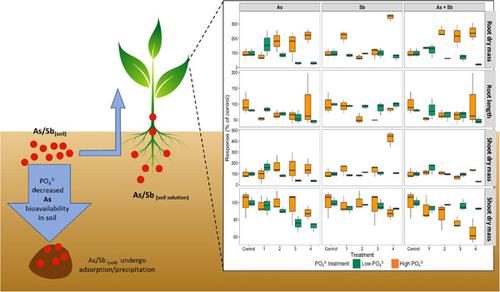当前位置:
X-MOL 学术
›
Environ. Toxicol. Chem.
›
论文详情
Our official English website, www.x-mol.net, welcomes your
feedback! (Note: you will need to create a separate account there.)
Influence of Soil Phosphate on the Accumulation and Toxicity of Arsenic and Antimony in Choy Sum Cultivated in Individually and Co-contaminated Soils.
Environmental Toxicology and Chemistry ( IF 3.6 ) Pub Date : 2020-03-06 , DOI: 10.1002/etc.4708 Lakmini P Egodawatta 1 , Aleicia Holland 2 , Darren Koppel 1, 3 , Dianne F Jolley 1, 3
Environmental Toxicology and Chemistry ( IF 3.6 ) Pub Date : 2020-03-06 , DOI: 10.1002/etc.4708 Lakmini P Egodawatta 1 , Aleicia Holland 2 , Darren Koppel 1, 3 , Dianne F Jolley 1, 3
Affiliation

|
Fertilizers containing phosphate (PO4 3- ) are commonly used within the agricultural industry and are known to increase the bioavailability and mobility of metalloids like arsenic (As). This may increase plant uptake of As and hence pose a risk to human health. Arsenic and antimony (Sb) often co-occur in contaminated soils; however, little is known about the interactions between As and Sb with PO4 3- on their bioavailability, accumulation, and toxicity in plants. The present study investigated individual and combined As and Sb-contaminated soils across 2 soil PO4 3- concentrations using a commonly consumed leafy vegetable, choy sum (Brassica chinensis var. parachinensis). Increased soil PO4 3- had no clear influence on the bioavailability of As or Sb (derived from a sequential extraction procedure). At high PO4 3- concentration, B. chinensis accumulated higher amounts of As in the shoots and roots in both individual and co-contaminated soil, whereas Sb accumulation increased only when Sb was the only contaminant. When As was the only contaminant, the translocation of As from roots to shoots decreased as soil PO4 3- increased. Increased soil PO4 3- had no influence on Sb translocation from root to shoot. Although As was toxic (impaired growth) at low PO4 3- soil concentration, no toxicity was observed in the high-PO4 3- soil. No toxicity was observed for Sb in either low- or high-PO4 3- soils. Increased soil PO4 3- concentration ameliorated or masked As toxicity to plant growth and led to higher As concentration in the plant's edible parts. The addition of high soil PO4 3- concentrations ameliorated or masked As toxicity to plant growth in both individually and As + Sb co-contaminated soil; however, the plant's edible parts accumulated higher As and Sb concentrations. Environ Toxicol Chem 2020;39:1233-1243. © 2020 SETAC.
中文翻译:

土壤磷肥对单独污染和共同污染的土壤中种植的蔡菜中砷和锑的积累和毒性的影响。
含磷酸盐(PO4 3-)的肥料通常用于农业行业,并且已知会增加诸如砷(As)之类的金属的生物利用度和迁移率。这可能会增加植物对砷的吸收,从而对人体健康构成威胁。砷和锑(Sb)经常同时存在于受污染的土壤中。然而,人们对砷和锑与PO4 3-的相互作用在植物中的生物利用度,积累和毒性知之甚少。本研究使用一种常见的叶菜类蔬菜(菜心)(Brassica chinensis var。parachinensis)调查了2种土壤PO4 3-浓度下的单个和混合As和Sb污染土壤。增加的土壤PO4 3-对As或Sb的生物利用度没有明显影响(源自顺序提取程序)。在高PO4 3-浓度下,B。在单独和共同污染的土壤中,中华草在茎和根中积累了更多的As,而Sb的积累仅在Sb是唯一的污染物时才增加。当As是唯一的污染物时,随着土壤PO4 3-的增加,As从根到芽的转运减少。土壤PO4 3-含量增加对Sb从根到芽的转运没有影响。尽管As在低PO4 3-土壤浓度下有毒(生长受损),但在高PO4 3-土壤中未观察到毒性。在低或高PO4 3-土壤中均未观察到Sb的毒性。升高的土壤PO4 3-浓度减轻或掩盖了As对植物生长的毒性,并导致植物可食部分中As浓度升高。高浓度土壤PO4 3-的添加改善或掩盖了砷对植物生长的毒性,无论是单独污染还是被As + Sb共同污染的土壤;然而,植物的可食部分积累了更高的砷和锑浓度。Environ Toxicol Chem 2020; 39:1233-1243。©2020 SETAC。
更新日期:2020-03-06
中文翻译:

土壤磷肥对单独污染和共同污染的土壤中种植的蔡菜中砷和锑的积累和毒性的影响。
含磷酸盐(PO4 3-)的肥料通常用于农业行业,并且已知会增加诸如砷(As)之类的金属的生物利用度和迁移率。这可能会增加植物对砷的吸收,从而对人体健康构成威胁。砷和锑(Sb)经常同时存在于受污染的土壤中。然而,人们对砷和锑与PO4 3-的相互作用在植物中的生物利用度,积累和毒性知之甚少。本研究使用一种常见的叶菜类蔬菜(菜心)(Brassica chinensis var。parachinensis)调查了2种土壤PO4 3-浓度下的单个和混合As和Sb污染土壤。增加的土壤PO4 3-对As或Sb的生物利用度没有明显影响(源自顺序提取程序)。在高PO4 3-浓度下,B。在单独和共同污染的土壤中,中华草在茎和根中积累了更多的As,而Sb的积累仅在Sb是唯一的污染物时才增加。当As是唯一的污染物时,随着土壤PO4 3-的增加,As从根到芽的转运减少。土壤PO4 3-含量增加对Sb从根到芽的转运没有影响。尽管As在低PO4 3-土壤浓度下有毒(生长受损),但在高PO4 3-土壤中未观察到毒性。在低或高PO4 3-土壤中均未观察到Sb的毒性。升高的土壤PO4 3-浓度减轻或掩盖了As对植物生长的毒性,并导致植物可食部分中As浓度升高。高浓度土壤PO4 3-的添加改善或掩盖了砷对植物生长的毒性,无论是单独污染还是被As + Sb共同污染的土壤;然而,植物的可食部分积累了更高的砷和锑浓度。Environ Toxicol Chem 2020; 39:1233-1243。©2020 SETAC。











































 京公网安备 11010802027423号
京公网安备 11010802027423号